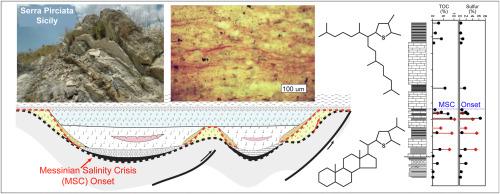Onset of the Messinian Salinity Crisis: Insights from molecular organic geochemistry
IF 3.6
2区 地球科学
Q1 GEOSCIENCES, MULTIDISCIPLINARY
引用次数: 0
Abstract
The Messinian Salinity Crisis (MSC) generated extensive anoxic sediments under the evaporitic deposits in marginal Mediterranean basins. In an interdisciplinary approach combining field work with multiple laboratory techniques, the oil source rock potential and biomarkers of pre-evaporitic Messinian sediments from the Caltanissetta Basin (Sicily) were evaluated using Rock-Eval pyrolysis, gas chromatography-mass spectrometry, isotopic analysis and optical and electron microscopy. Organic-rich samples from the 45 m Serra Pirciata section consist of cycles of diatomaceous and carbonate layers alternating with organic shales of variable TOC. The organic matter is mostly optically amorphous, increasing in content upwards in the section. Of the 43 samples analyzed within the section, an especially organic- and sulfur-rich interval shows TOC values up to 10 %, and oil generation potential (Rock-Eval S2) up to 75 mg HC/g rock. Samples show Rock-Eval Hydrogen Indices (HI) up to ca. 800 mg HC/g TOC, but most fall in the range of 300–600 mg HC/g TOC, indicating type II kerogen. Within this section, a specific interval is especially remarkable for its unusual biomarker assemblage, having abundant sulfur compounds including isoprenoid, steroid, and hopanoid thiophenes and thiolanes, as well as microscopic sponge fossils. We propose that this organic-rich interval with its distinctive biomarkers represents an initial episode of basin restriction and, based on cyclostratigraphic interpretations, constitutes a non-evaporitic record of the onset of the MSC in the deeper part of the Caltanissetta Basin, where gypsum deposits were initially absent. If the depocenter of the Caltanissetta Basin is an analog for the deep Mediterranean basin, these results suggest that a large volume of organic matter of bacterial origin accumulated in the deep Mediterranean prior to evaporitic deposition.

墨西尼亚盐度危机的开始:来自分子有机地球化学的见解
迈西尼亚盐危机(MSC)在地中海边缘盆地的蒸发沉积下产生了广泛的缺氧沉积。采用跨学科的方法,结合现场工作和多种实验室技术,利用岩石热解、气相色谱-质谱、同位素分析、光学和电子显微镜对西西里岛Caltanissetta盆地前蒸发期迈西旦期沉积物的油源岩潜力和生物标志物进行了评估。45 m Serra Pirciata剖面的富有机质样品由硅藻质和碳酸盐层的旋回与可变TOC的有机页岩交替组成。有机质大部分为光学无定形,在剖面上含量向上增加。在该剖面分析的43个样品中,一个特别富有机和富硫的层段显示TOC值高达10%,生油潜力(rock - eval S2)高达75 mg HC/g岩石。岩石评价氢指数(HI)可达800 mg HC/g TOC左右,但大部分在300 ~ 600 mg HC/g TOC之间,为ⅱ型干酪根。在这一剖面中,一个特定的层段因其不寻常的生物标志物组合而特别引人注目,其中含有丰富的含硫化合物,包括类异戊二烯、类固醇、类藿烷噻吩和噻烷,以及微观海绵化石。根据旋回地层的解释,我们认为这个富含有机物的层段代表了盆地限制的初始阶段,构成了Caltanissetta盆地深层MSC开始的非蒸发记录,那里最初没有石膏矿床。如果Caltanissetta盆地的沉积中心与地中海盆地相似,那么这些结果表明,在蒸发沉积之前,大量细菌来源的有机质在地中海深处积累。
本文章由计算机程序翻译,如有差异,请以英文原文为准。
求助全文
约1分钟内获得全文
求助全文
来源期刊

Marine and Petroleum Geology
地学-地球科学综合
CiteScore
8.80
自引率
14.30%
发文量
475
审稿时长
63 days
期刊介绍:
Marine and Petroleum Geology is the pre-eminent international forum for the exchange of multidisciplinary concepts, interpretations and techniques for all concerned with marine and petroleum geology in industry, government and academia. Rapid bimonthly publication allows early communications of papers or short communications to the geoscience community.
Marine and Petroleum Geology is essential reading for geologists, geophysicists and explorationists in industry, government and academia working in the following areas: marine geology; basin analysis and evaluation; organic geochemistry; reserve/resource estimation; seismic stratigraphy; thermal models of basic evolution; sedimentary geology; continental margins; geophysical interpretation; structural geology/tectonics; formation evaluation techniques; well logging.
 求助内容:
求助内容: 应助结果提醒方式:
应助结果提醒方式:


